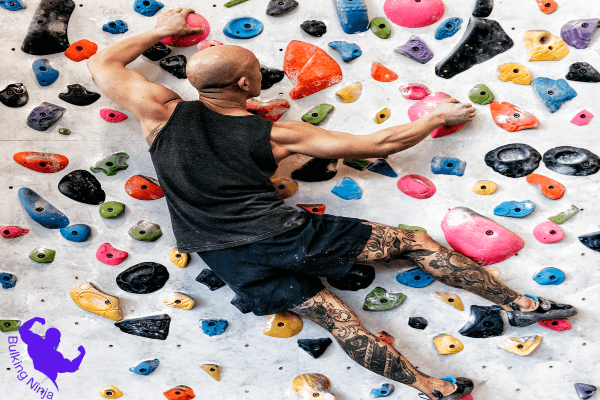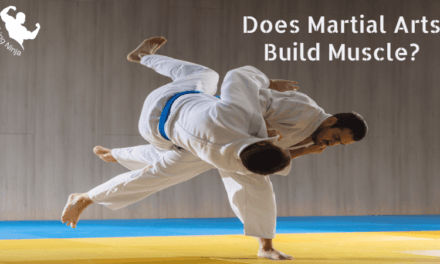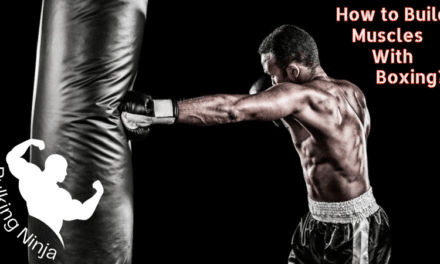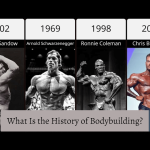Welcome to the intriguing world of bouldering, where the challenge of scaling rocks and walls goes hand in hand with the pursuit of physical fitness. Amidst the awe-inspiring feats of strength and agility displayed by boulders, a question lingers: Can bouldering truly lead to muscle gain? In a realm dominated by conventional weightlifting and gym-centric workouts, bouldering stands as a distinct approach to building strength and muscle.
In this blog post, we embark on an exploration of the relationship between bouldering and muscle development, delving into the science, strategies, and experiences that shed light on the potential of this exhilarating activity to sculpt not only climbers’ physiques but also redefine our understanding of effective muscle-building methods.
Whether you’re a seasoned climber or a curious fitness enthusiast, join us as we ascend the precipice of understanding to uncover the captivating truths behind the question: Does bouldering gain muscle?
Table of Contents
- Does Bouldering Gain Muscle?
- What Muscles are Used in Climbing?
- Is Climbing a Viable Alternative to Gym Workouts?
- Will Rock Climbing Build Muscle?
- Can Bouldering Build Strong Muscle?
- Frequently Asked Questions
- Can You Build Muscle With Bouldering?
- What Muscles Does Bouldering Improve?
- Does Bouldering Count As Strength Training?
- Does Bouldering Get You Ripped?
- Can You Get A Six Pack From Bouldering?
- Is Bouldering 3 Times A Week Too Much?
- Why Is Bouldering So Addictive?
- How Many Calories Does 3 Hours Of Bouldering Burn?
- Conclusion
Does Bouldering Gain Muscle?

Climbers who engage in bouldering, a form of climbing that utilizes bodyweight activity, can experience impressive gains in muscular endurance and strength. The advanced technique required for successful bouldering involves repeated reaches and holds, which significantly improves both muscle composition and flexibility.
Research has shown that the repetition involved in pulling and pushing one’s weight during climbs enhances the strength of the biceps and other upper body muscles. While climbing alone helps tone and strengthen these muscles, incorporating specific strength training exercises can further complement the overall muscle-building process.
For those beginning their climbing journey, the initial period of muscle building is particularly noteworthy, but even as climbers progress and technique becomes more crucial, the foundation of muscle gained through bouldering remains essential for continued improvement. In essence, bouldering proves itself as an effective method for building and maintaining muscle strength, even as climbers advance to higher levels of technique and expertise.
What Muscles are Used in Climbing?

Climbing, whether it’s on natural rock faces or indoor walls, is a captivating sport that demands strength, endurance, and a strategic approach. It engages a multitude of muscles, working in harmony to propel climbers upwards. Understanding the key muscles involved can not only improve your climbing performance but also aid in crafting a well-rounded fitness routine.
Forearm Flexors: The Powerhouses
At the forefront of climbing prowess are the forearm flexors, a group of muscles responsible for gripping and holding onto holds. These muscles, including the flexor digitorum profundus and flexor digitorum superficialis, endure immense strain during climbs, especially in crux moves that require prolonged gripping. Training these muscles is crucial for building grip strength and preventing early fatigue during climbs. Read more about limite to Build muscles.
Lats and Rhomboids: Back Strength
As climbers pull themselves upwards, their latissimus dorsi (lats) and rhomboid muscles come into play. The lats, spanning from the upper arm to the lower back, provide the strength needed for dynamic movements like dynamic reaches and lock-offs. Meanwhile, the rhomboids, situated between the shoulder blades, stabilize the shoulder girdle and aid in maintaining balance on the wall.
Core Muscles: Stability and Balance
Climbing engages the core like few other activities. Core muscles, including the rectus abdominis, obliques, and transverse abdominis, are vital for stabilizing the body and maintaining balance while reaching for holds. A strong core not only improves overall climbing performance but also reduces the risk of injury by providing a stable foundation for dynamic moves.
Leg Muscles: Pushing and Smearing
While climbing may seem like an upper body-focused activity, leg muscles play an essential role, especially in techniques like smearing and pushing off the wall. The quadriceps, hamstrings, and calf muscles work collectively to generate upward momentum and control foot placement. Strong leg muscles enable climbers to utilize their lower body effectively, conserving upper body strength for more demanding moves.
Finger Flexors: Precision and Control
In delicate climbing situations that demand precision and control, finger flexors like the flexor digitorum profundus come into play. These smaller muscles provide the finesse required for intricate holds and crimps. Regular finger strength training enhances grip capabilities, making it easier to conquer challenging routes. Further Read more about gain muscles with Badminton.
Climbing is a holistic sport that requires a symphony of muscles working together in perfect harmony. Developing strength and endurance in these muscle groups not only enhances climbing performance but also contributes to overall fitness.
Incorporating exercises that target these muscles into your training routine can lead to significant improvements in climbing abilities and a deeper appreciation for the physical demands of this exhilarating sport.
So, whether you’re a seasoned climber or a beginner eager to ascend new heights, understanding the muscles involved is the first step towards conquering your climbing goals. Read more about Important types of Pushups for gaining muscles.
Is Climbing a Viable Alternative to Gym Workouts?

In a world where gym routines and traditional workouts dominate the fitness landscape, there’s a growing tribe of individuals who seek a different path to staying active and healthy. For many, climbing emerges as a captivating choice, offering an engaging and challenging way to work out while steering clear of the traditional gym environment. Lets Start your fitness journey with different ways to gain muscle without weights lifting.
Climbing: The Cardio Twist
Climbing, in its essence, is an intense cardio workout that often doesn’t feel like one. The continuous movement, bursts of energy, and focus required during a climb can elevate your heart rate, improving cardiovascular endurance.
This aspect alone sets climbing apart from sedentary activities and positions it as an appealing cardio alternative for those who shun the monotony of treadmills or stationary bikes.
Climbing vs. Traditional Gym Workouts
In the realm of fitness, climbing offers distinct advantages over traditional gym workouts. It engages not only the muscles of the upper body but also recruits the core and leg muscles in unique ways. The dynamic nature of climbing challenges your balance, flexibility, and mental acuity, contributing to a well-rounded fitness regimen.
Climbing’s versatility shines especially bright when compared to conventional gym routines. Instead of repetitive sets and isolated movements, climbers navigate intricate routes that require problem-solving and creativity. This mental engagement adds an extra layer of satisfaction and keeps workouts from becoming mundane.
The Quest for Muscles and Strength
While climbing holds its own in terms of fitness benefits, it might not be the ultimate solution for everyone’s goals. Those aspiring to develop substantial muscle mass or excel in traditional weightlifting pursuits like bench pressing and squatting might find it necessary to complement their climbing routine with dedicated weight lifting.
Weight lifting allows for targeted muscle development that might not be fully achieved through climbing alone. If the aim is to lift twice your body weight or sculpt impressive bulging muscles, incorporating resistance training is a logical choice. Read how does Swimming make your muscles strong.
Finding Your Balance
Ultimately, the decision to exclusively climb or integrate weight lifting hinges on your fitness objectives. Climbing unquestionably delivers an engaging cardio workout and builds functional strength that translates to real-world scenarios. It’s an appealing solution for those who prefer a dynamic, outdoor-oriented approach to fitness.
However, acknowledging that each individual’s goals are unique is vital. If building substantial muscle mass or focusing on specific strength goals is your aspiration, there’s no harm in introducing weight lifting alongside climbing. The key lies in finding a balance that aligns with your fitness vision while keeping your enthusiasm and motivation intact. Further read about Oats are best diet for grow muscles.
Climbing stands as a refreshing departure from traditional workouts, offering a cardio-packed adventure that engages both body and mind. While it can fulfill a wide range of fitness goals, it’s essential to assess whether incorporating weight lifting aligns with your specific aspirations. Striking the right balance will pave the way for a fulfilling and holistic fitness journey that speaks to your individuality. Study more about who is better Gym or Martial arts for grow muscles.
Will Rock Climbing Build Muscle?
The Muscles at Play
Rock climbing engages a wide array of muscles, forming the foundation of its effectiveness as a muscle-building activity. The primary muscles involved can be categorized into two main groups: the upper body muscles and the core and lower body muscles.
Upper Body Muscles
Forearm Flexors the constant gripping and holding onto holds demand significant strength from the forearm flexors. These muscles, particularly the flexor digitorum profundus and flexor digitorum superficialis, experience intense activation throughout a climb. The repeated contractions as you grasp onto holds are akin to a natural resistance exercise, aiding in muscle development.
Lats and Rhomboids the lats, which stretch across the back, are heavily engaged during pulling movements in climbing. They provide the strength necessary for dynamic reaches and pull-ups. The rhomboids, located between the shoulder blades, stabilize the shoulders, aiding in maintaining balance and supporting the upper body during climbs.
Core and Lower Body Muscles:
Core Muscles Climbing necessitates a stable core to maintain balance and control while reaching for holds. The core muscles, including the rectus abdominis, obliques, and transverse abdominis, work synergistically to stabilize the body during dynamic movements. A strong core not only enhances climbing performance but also contributes to overall core strength.
Leg Muscles while climbing is often associated with upper body strength, the lower body plays a crucial role. The quadriceps, hamstrings, and calf muscles assist in pushing off the wall and controlling foot placement. These muscles are particularly important in techniques like smearing and flagging.
The Muscle Building Process
Rock climbing induces muscle building through a combination of factors. The sustained effort required to ascend a route activates both slow-twitch and fast-twitch muscle fibers, promoting muscle growth and endurance. The constant resistance applied to various muscle groups during gripping and pulling against holds stimulates hypertrophy, or muscle growth, over time.
Moreover, climbing challenges muscles in unique ways due to its dynamic and multifaceted nature. The varying holds, angles, and movements engage muscles from different angles, contributing to a well-rounded muscle development. Additionally, the intensity of climbing sessions can lead to muscle fatigue and micro-tears, which, when repaired, contribute to muscle growth and strength enhancement.
Can Bouldering Build Strong Muscle?

Bouldering, a thrilling subset of rock climbing that emphasizes short, powerful routes without the use of ropes, has captured the attention of fitness enthusiasts seeking a dynamic and engaging workout. One question often asked is whether bouldering has the potential to build strong muscle. Let’s delve into the world of bouldering and its impact on muscle strength.
Muscle Engagement in Bouldering
Bouldering demands a significant amount of strength and power, making it an effective activity for building strong muscles. The nature of bouldering routes, characterized by challenging moves and s[hort bursts of intense effort, places substantial stress on various muscle groups.
Bouldering heavily targets the upper body, particularly the muscles involved in pulling and gripping. As climbers navigate overhangs, crimps, and dynamic movements, muscles like the forearm flexors, lats, rhomboids, and biceps come into play. The sustained effort required to grip holds and pull the body upwards contributes to muscle activation and growth.
The core muscles, essential for maintaining balance and control, are actively engaged during bouldering. As climbers twist, turn, and reach for holds, muscles such as the rectus abdominis, obliques, and transverse abdominis are put to the test. Additionally, lower body muscles including the quadriceps, hamstrings, and calf muscles are utilized for pushing off the wall and maintaining stability.
Bouldering’s potential for building strong muscles is attributed to several factors. The explosive and powerful movements required to tackle boulder problems activate fast-twitch muscle fibers, which are associated with strength and power. These short bursts of intense effort contribute to muscle development, particularly when combined with controlled and precise movements.
Furthermore, bouldering challenges muscles in a functional manner. The body adapts to the varied holds, angles, and movements, leading to muscle growth and improved muscle coordination. The combination of strength and technique required in bouldering promotes well-rounded muscle development and a balanced physique.
In the realm of muscle building, bouldering stands as a viable contender. The sport’s emphasis on powerful movements, upper body engagement, and dynamic core control makes it an effective way to strengthen muscles. While it may not replicate the targeted muscle growth achieved through traditional weight lifting, bouldering offers a unique blend of strength, skill, and cardiovascular exercise. Whether you’re a seasoned climber or a newcomer to the sport, bouldering can indeed contribute to building strong muscles while delivering an exciting and rewarding fitness experience. Read more about Breakfast is important for gaining muscles.
Frequently Asked Questions
Can You Build Muscle With Bouldering?
Bouldering serves as an excellent strength training activity. While consistently climbing more frequently and for longer sessions won’t necessarily lead to continuous significant muscle growth, it will help you maintain a toned and defined physique, which is often the sought-after appearance among climbers.
What Muscles Does Bouldering Improve?
Bouldering improves forearm flexors, lats, core muscles, and lower body muscles.
Does Bouldering Count As Strength Training?
Bouldering provides an effective strength training experience that promotes muscle growth, endurance, and power. Its unique combination of resistance, compound movements, and engagement of various muscle groups makes it a valuable addition to a well-rounded fitness routine.
Whether you’re a beginner or an experienced climber, bouldering can help you achieve your strength and fitness goals while enjoying a dynamic and exhilarating activity.
Does Bouldering Get You Ripped?
Bouldering can contribute to a toned and defined physique, but achieving a “ripped” appearance depends on various factors including diet, genetics, and training intensity.
Can You Get A Six Pack From Bouldering?
Bouldering can engage your core muscles and contribute to a stronger core, which is a key factor in achieving a six-pack appearance. However, diet, overall body fat percentage, and genetics also play significant roles in revealing well-defined abdominal muscles.
Is Bouldering 3 Times A Week Too Much?
Bouldering three times a week can be a suitable frequency for many climbers, especially if you gradually increase intensity and allow for proper recovery between sessions.
However, individual factors like fitness level, experience, recovery capacity, and overall workload should be considered. Listening to your body and adjusting your routine accordingly is essential to avoid overtraining.
Why Is Bouldering So Addictive?
Bouldering is addictive due to its quick rewards, mental challenges, social aspect, physical exertion, progression, mindfulness, freedom, variety, fitness benefits, and adrenaline rush.
How Many Calories Does 3 Hours Of Bouldering Burn?
The number of calories burned during 3 hours of bouldering can vary based on factors like your weight, intensity, climbing difficulty, and individual metabolism. On average, bouldering can burn around 500 to 800 calories per hour.
So, 3 hours of bouldering might burn roughly 1500 to 2400 calories. Keep in mind that these are rough estimates, and individual variations can affect the actual calorie expenditure.
Conclusion
Gymnastics emerges as a potent force in the realm of muscle development, defying traditional norms. Its unique blend of strength, balance, and flexibility fosters lean and functional muscles that excel both in form and function.
This exploration has revealed the body’s incredible adaptability to gymnastics’ demands, promoting muscular endurance and growth.
By activating diverse muscle groups and promoting progressive overload, gymnastics shapes not only the aesthetics but also the practicality of muscles.
It’s an unconventional yet effective route to achieving muscle gain, inviting individuals to explore their body’s capabilities.
Whether a novice embarking on a new journey or an experienced gymnast fine-tuning their physique, gymnastics stands as a compelling avenue toward a stronger, more resilient self.














